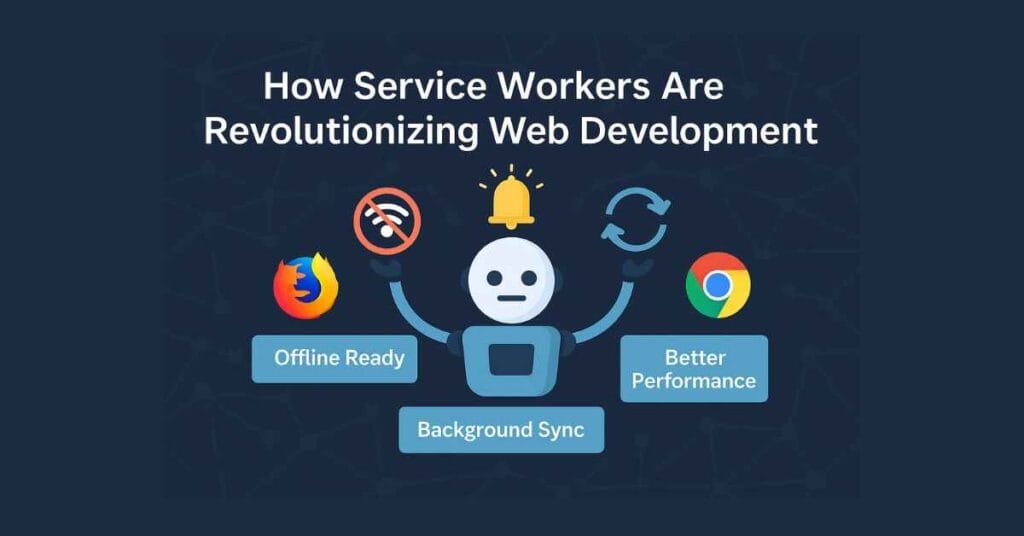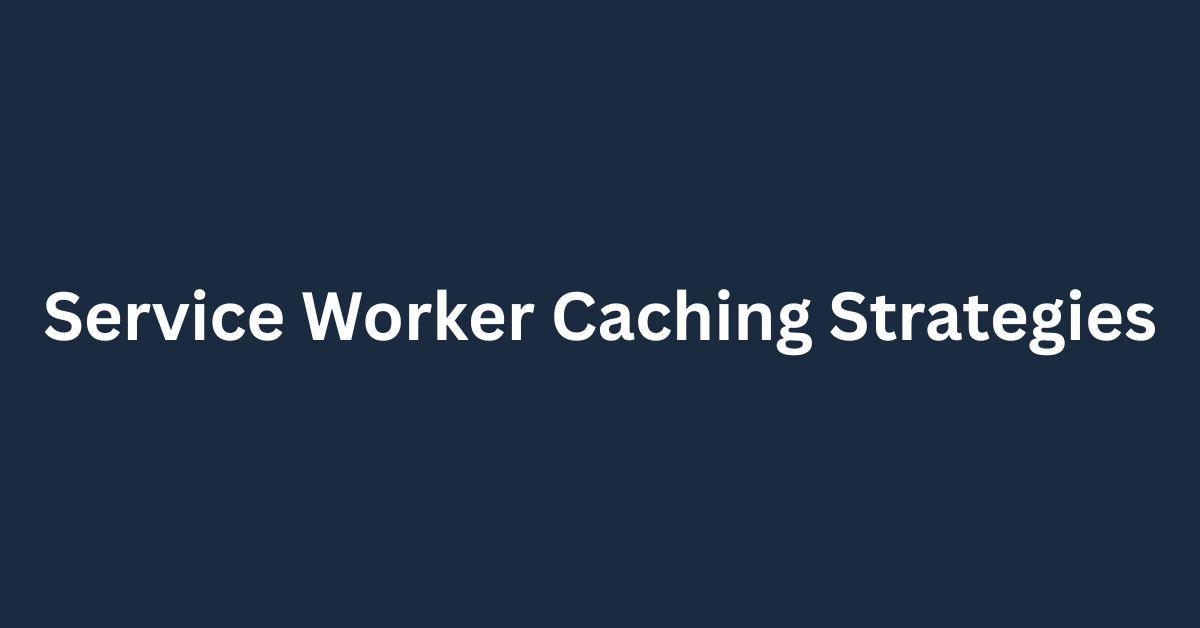|
Getting your Trinity Audio player ready... |
Introduction
Service workers play a crucial role in modern web development, revolutionizing how web applications function. They are key components that enable offline capabilities, background sync, and overall enhanced user experiences. As professionals in the digital industry, understanding the significance of service workers and their impact on web performance is essential for staying ahead in the ever-evolving tech landscape.

When it comes to optimizing web performance, caching strategies are paramount. By strategically storing and retrieving data, websites can load more quickly and deliver a seamless user experience. Implementing effective caching strategies not only boosts performance but also ensures that users can access content even when offline. In this section, we delve into the concept of service worker caching strategies, exploring how they can elevate your web applications to new heights of efficiency and reliability.
By incorporating the right caching strategies, you can significantly improve the speed and responsiveness of your web applications, ultimately leading to increased user satisfaction and engagement. Stay tuned as we uncover the best practices and real-world examples of service worker caching strategies to help you optimize your web development projects.
Understanding Service Workers
Service workers are a fundamental aspect of modern web development, acting as scripts that your browser runs in the background. They are essential for enabling offline capabilities and background synchronization, allowing web applications to function seamlessly even without an active internet connection. By leveraging service workers, websites can provide users with a consistent experience regardless of their connectivity status.
One of the key benefits of service workers is their ability to cache resources, such as HTML pages, CSS stylesheets, and JavaScript files. This caching mechanism allows websites to load faster by storing previously accessed data locally on the user’s device. As a result, users can enjoy quicker page loads and smoother navigation, enhancing their overall browsing experience.
In the fast-paced digital landscape, where user expectations for speed and performance are high, understanding service workers is crucial for professionals in the web development industry. By harnessing the power of service workers and implementing effective caching strategies, developers can create web applications that are not only reliable and efficient but also capable of delivering exceptional user experiences.
Importance of Caching Strategies
The “Importance of Caching Strategies” cannot be overstated in the realm of web development. Implementing efficient caching mechanisms is paramount for enhancing website speed and performance, which directly impacts user experience and engagement. By storing frequently accessed resources locally, caching significantly reduces loading times, ensuring that users can navigate through web pages swiftly and seamlessly. This not only meets the high-speed expectations of today’s digital landscape but also contributes to a positive browsing experience for all visitors.
Moreover, effective caching strategies play a crucial role in reducing server load and minimizing bandwidth usage. By serving cached content instead of repeatedly fetching data from the server, websites can operate more efficiently, leading to cost savings and improved overall performance. Professionals in the web development industry understand that optimizing caching strategies is not just about technical enhancements but also about creating a more sustainable and user-friendly online environment.
In a competitive online market, where every second counts, mastering caching strategies is key to staying ahead and delivering exceptional web experiences. By prioritizing caching, developers can ensure that their websites are not only fast and responsive but also cost-effective and user-centric.
Common Service Worker Caching Strategies
Common Service Worker Caching Strategies
When it comes to optimizing website performance, implementing the right caching strategy is crucial. One common approach is the **Cache First Strategy**. This method prioritizes retrieving resources from the cache before reaching out to the network, ensuring faster load times and a smoother user experience. While it enhances speed and reduces server load, it may sometimes lead to users receiving outdated content.
On the other hand, the **Network First Strategy** flips the script by fetching resources from the network first and then falling back to the cache if needed. This strategy ensures users always get the latest data but can result in slower loading times if the network connection is poor.
The **Cache Only Strategy** solely relies on cached resources, making it ideal for static content that rarely changes. However, it may pose challenges when dealing with dynamic data that requires real-time updates.
Conversely, the **Network Only Strategy** fetches resources exclusively from the network, bypassing the cache altogether. While this guarantees up-to-date information, it can lead to slower loading speeds and increased server load.
Lastly, the **Stale-While-Revalidate Strategy** strikes a balance by serving stale content from the cache while simultaneously updating it in the background. This approach offers a compromise between speed and freshness but requires careful implementation to avoid serving outdated data.
Best Practices for Implementing Caching Strategies
When implementing caching strategies for your web application, it’s crucial to follow best practices to ensure optimal performance and data freshness. One key tip is to carefully consider the nature of your content and user interactions to choose the most suitable caching strategy. Balancing speed with the need for up-to-date information is essential.
To achieve this balance, regularly review and adjust your caching strategy based on the dynamic nature of your content. Implement mechanisms to refresh cached data at appropriate intervals to maintain data accuracy without compromising speed. Additionally, consider implementing fallback mechanisms to handle scenarios where cached data may be outdated or unavailable.
Avoid common pitfalls such as over-caching, which can lead to serving stale content, or under-caching, resulting in excessive network requests and slower load times. Test your caching strategy thoroughly across different scenarios to identify and address any performance bottlenecks or data inconsistencies.
By following these best practices, you can ensure that your caching strategy effectively enhances website performance while providing users with the most relevant and up-to-date content.
Real-World Examples
Real-World Examples
Exploring real-world examples of successful implementations of “service worker caching strategies” provides valuable insights into effective web performance optimization. Case studies from industry leaders in web development showcase the practical application of caching strategies in diverse scenarios. These examples highlight the impact of caching on user experience, load times, and overall website performance.
By studying these cases, professionals can glean valuable lessons on optimizing caching strategies to meet specific user needs and content requirements. Understanding how different industries leverage caching to enhance their web applications can inspire innovative approaches to improving data freshness and speed.
Industry leaders in web development have demonstrated the power of strategic caching in delivering dynamic content efficiently. Their experiences serve as a roadmap for professionals looking to elevate their web performance through well-executed caching strategies. By learning from these real-world examples, professionals can adapt proven techniques to their own projects, ensuring a seamless user experience and competitive edge in the digital landscape.
Conclusion
Concluding the exploration of service worker caching strategies, it is evident that implementing robust caching mechanisms is crucial for enhancing web performance. By leveraging “service worker caching strategies,” professionals can significantly improve user experience and website speed. Real-world examples have showcased the tangible benefits of strategic caching in various industries, emphasizing the need for tailored approaches to meet specific content requirements.
As professionals delve into the realm of caching strategies, it becomes clear that continuous optimization is key to staying ahead in the digital landscape. The dynamic nature of web development necessitates a proactive stance towards refining caching techniques to ensure data freshness and seamless user interactions. Embracing best practices and learning from successful implementations can empower professionals to elevate their projects and deliver exceptional web experiences.
In the ever-evolving digital sphere, the future of web performance optimization lies in the hands of those who embrace innovative caching strategies. By staying informed, experimenting with new approaches, and prioritizing user-centric optimizations, professionals can navigate the complexities of modern web development with confidence and efficiency.
Additional Resources
To fully leverage the power of service workers and implement advanced caching strategies, it’s essential to explore high-quality external resources. Below is a curated list of articles, tutorials, and tools to guide you on this journey.
Comprehensive Guides & Tutorials
- 🔗 MDN Web Docs – Using Service Workers
In-depth documentation with examples and progressive enhancement techniques.
🧰 Tools and Libraries
- ⚙️ Workbox (by Google)
A powerful JavaScript library for managing service workers and caching. - ⚙️ SW-Precache & SW-Toolbox (Deprecated, but useful references)
Legacy tools that inspired Workbox; helpful for understanding historical implementations. - ⚙️ PWA Builder
Quickly scaffold a service worker with caching strategies and offline support.
🧠 Stay Ahead
By integrating these resources into your workflow, you’ll be equipped to:
- Create robust offline experiences
- Optimize performance using cache layering
- Reduce server loads and latency
- Deliver better user engagement
✅ Tip: Bookmark these resources or store them in your team’s knowledge base for quick reference.
The Future of Web Hosting: From Shared Servers to Edge Functions
Cloudflare Explained: Optimize Your Website’s Speed and Security
Arsalan Malik is a passionate Software Engineer and the Founder of Makemychance.com. A proud CDAC-qualified developer, Arsalan specializes in full-stack web development, with expertise in technologies like Node.js, PHP, WordPress, React, and modern CSS frameworks.
He actively shares his knowledge and insights with the developer community on platforms like Dev.to and engages with professionals worldwide through LinkedIn.
Arsalan believes in building real-world projects that not only solve problems but also educate and empower users. His mission is to make technology simple, accessible, and impactful for everyone.



